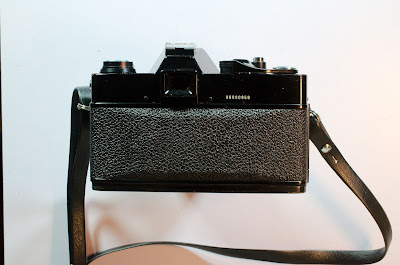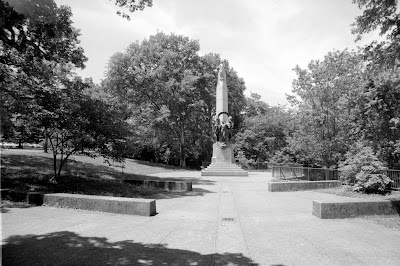The camera has a metal body and a black finish. The top of the camera has the film loaded indicator, the rewind crank, the flash shoe, the shutter speed dial, the film speed dial, the shutter release, the film advance lever and the exposure counter. The front of the camera has the self timer lever, the M42 lens mount and the exposure meter switch. The bottom of the camera has the rewind button, the tripod socket and the battery compartment. The left side of the camera has PC sync sockets for flash bulbs (M) and electronic flash (X).
The shutter speeds run from 1 second to 1/1000 second plus bulb. The shutter is a metal, vertically running Copal shutter that syncs with electronic flash at 1/125 second or longer exposures. The shutter is completely mechanical. No battery is needed except for the light meter.
The lens mount is a 42 mm screw mount (Pentax/Praktica/Universal/M42 lens mount). The camera came with either an f/2.8, 55 mm lens with four elements in three groups or an f/1.8, 50 mm lens with six elements in four groups. Most M42 mount lenses will fit this camera. An f/2.8 35mm Vivitar lens is on the camera now.
The camera has a through the lens exposure meter. The meter needle is visible in the lower right of the viewfinder. To get an exposure reading you press a switch on the lens mount to simultaneously stop down auto diaphragm lenses to shooting aperture and turn the light meter on. The picture is correctly exposed when the needle is centered between the brackets, underexposed when it is down toward the "-" sign, and over exposed when up toward the "+" sign. The meter gives an average reading over the entire picture and can be fooled by uneven lighting. The meter can be set for ASA (now ISO) film speeds from 24 to 1600. With 100 speed film the metering range is from EV 3 (average indoor scenes) to EV 18 (extremely bright daylight).
The exposure meter is powered by a size 675 button cell. The required 1.35 volt mercury cell is no longer available because of the toxicity of mercury. A 1.4 volt zinc-air hearing aid battery is close, but the meter readings on my camera were not very accurate with a hearing aid battery. You can just ignore the camera's meter and use a handheld exposure meter or use the camera settings recommended in the data sheet for your film.
For focusing the viewfinder has a central micro-prism circle surrounded by a ground glass ring. The micro-prisms tend to black out with telephoto lenses. When that happens you would use the ground glass area to focus.
The rewind crank pulls up to open the back for loading film and the exposure counter resets to "start" when the back is opened. It takes three pulls on the film advance lever to reach the first frame, and one pull on the lever to advance to subsequent frames. An indicator next to the rewind crank shows red when there's film in the camera.
The Vivitar 220/SL is an average, low-price, manual 35 mm SLR. You can buy one nowadays for about $20.
Sample Photo with a 28mm wide angle lens




No comments:
Post a Comment